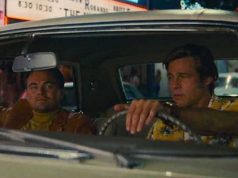“Shadow of the Vampire,” about the filming of an old movie, itself has several qualities we associate with old movies: a too-long opening credit sequence, a simple premise without a lot of depth, and over-the-top acting, for example. You may have noticed that these are not good qualities. To be fair, though, “Shadow of the Vampire” overcomes the handicaps it gives itself and turns out to be a rather entertaining picture.
The film explores a giggly “what-if?” conceit: What if the man who played the vampire in the legendary silent film “Nosferatu” really WAS a vampire? This is an audacious thing to make a movie about; after all, these are actual, historical people here, and we’re assigning attributes to them that have no basis in fact (or even in urban legend).
The man in question is Max Schreck (Willem Dafoe), who in “Shadow” is recruited by egomaniacal director F.W. Murnau (John Malkovich) to play Count Orlock (Bram Stoker’s estate wouldn’t let them use “Dracula,” so they lifted the story and changed the names).
Cast and crew know that Schreck is mercurial and odd, so immersed in his character that he only allows filming at night and never appears in front of others except in full makeup and costume. We and Murnau know that he’s an actual vampire who doesn’t need makeup, doing the work of an actor because Murnau has promised to let him liquidate leading lady Greta Shroder (Catherine McCormack) when it’s all over. (So much for the film-plugging talk-show circuit.)
There is some devilish humor in having a monster working as an actor — finding his marks, standing still for measurements, and so on. The other people working on the film take delight in asking Schreck teasingly about the life of a vampire, and he answers truthfully — which amuses them no end, as they don’t realize he’s not just playing a character.
Though to my knowledge there were never any rumors about Max Schreck being a vampire, I think I may start one about Willem Dafoe. His malevolent grin borders on the cartoonish, and he skulks around in a most impressively creepy manner. I suspect Dafoe knows he’s over-acting most of the time, and he’s having so much fun doing it that it’s hard to complain.
If you’re not careful, you might not realize until the end that the real main character here is the director, Murnau. His drive to complete the film no matter what is where the movie’s heart is; Schreck’s behavior is just comic-book window-dressing.
The movie is better than the sum of its parts. Dafoe, Malkovich and Cary Elwes (as the cinematographer brought in after Schreck sucks the first one dry) are all top-notch in their roles, and the black-and-white footage used when the camera is rolling adds authenticity. Forget “Dracula 2000” (if you can); Dracula 1922 is where the real action is.
B+ (; )





